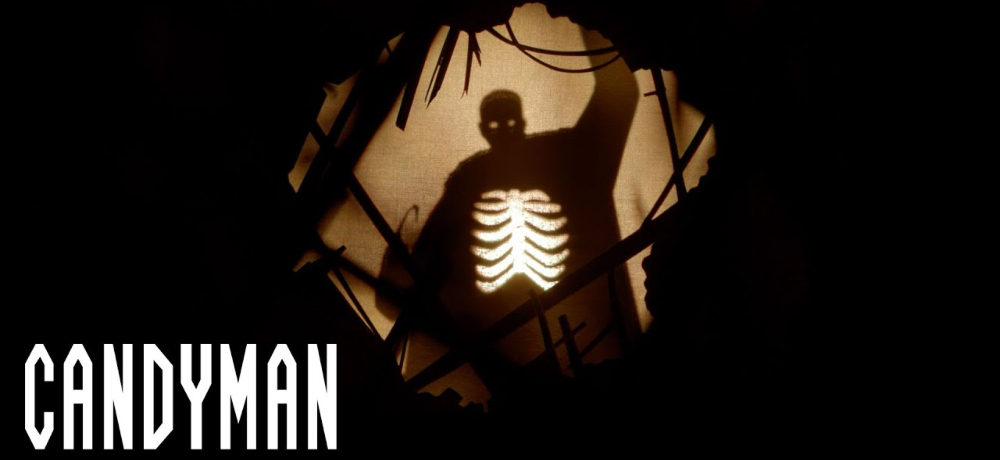


In 1992, director Bernard Rose brought author Clive Barker's short story, "The Forbidden," about an urban legend known as The Candyman, to gruesome cinematic life. The film starred Tony Todd as the hook-wielding ghoul who fell in love with the wrong woman and was punished by racists for his desire and Virginia Madsen as the inquisitive grad student searching the housing projects of Cabrini-Green in Chicago for the origins of the urban legend. By saying his name five times in the mirror, you invite the Candyman into the world, hook, gore, and all.
The film, which has grown a cult following over the years, is a rare horror film well ahead of its time in examining the injustices, frustrations, and rage for the treatment of Black people in America through the lens of genre filmmaking. While Bernard Rose's vision may offer a few unforgettable chills and a more than memorable villain, the story seemed only to graze the surface concerning the politics and social commentary found inherent in a story about the sins of America's past.
In the thought-provoking, confident continuation of the myth, directed by Nia DaCosta, Candyman's legend has been hushed to forgotten folklore, not even a bedtime story to scare the little ones. Gone are the distressed Cabrini-Green housing units, in their place, a gentrified living tower with sleek designs and floor-to-ceiling windows that illuminate the Chicago skyline. Candyman, in present times, isn't the one we remember from the past film. Instead, the tale exists with a falsely accused Black man blamed for giving candy with razor blades to White children. His demise, at the hand of aggressive law enforcement, is the lore that is remembered for current times.
The story of Candyman begins to take greater shape in DaCosta's account once a painter named Anthony (Yahya Abdul-Mateen II) begins exploring the ruins of Cabrini-Green. Anthony's insight and very soon obsession with the myth starts to consume him. The relationship with his girlfriend Brianna (Teyonah Parris) begins to suffer after Anthony's Candyman art exhibit ends with the gruesome murder of two people. Soon, Anthony comes face to face with the unspoken legend from the past, leading more unsuspecting people to remember and say his name.
DaCosta, who wrote the script along with Win Rosenfeld and Jordan Peele, takes this urban legend and imbues it with current themes of social commentary surrounding the injustices for people of color, the brutality inflicted on Black bodies, and the historical trauma, some as recent as last year, perpetrated throughout American history. It doesn't take profound observation to connect the tagline for this film, "Say His Name," to the Breonna Taylor incident that advocated to "Say Her Name."
The design of CANDYMAN paints Chicago as a modern landscape with deep history underneath its glossy exterior. The opening credits display a masked Chicago skyline hidden in the fog. It's a nice callback to the birds-eye introduction of the original film. And, instead of framing the scares and violence with an abundance of gore, DaCosta focuses her fear more on creepy factors utilizing mirror tricks and depth of field to display how close Candyman is throughout the film. It's a nice touch that allows this version of the myth to shape its unique atmosphere.
The perspective of CANDYMAN shifts, perhaps too often, between Anthony and Brianna as the film leads towards its ultimate culmination. When the third act hits, the emotional notes established for Anthony disappear to a large extent as the film focuses on Brianna's journey towards the truth the movie has kept a mystery.
In one of the film's best elements, DaCosta utilizes shadow puppets to reimagine the past and how stories are changed, exaggerated, and hidden the longer they are kept. It's a beautiful and elegant touch. It's within this technique that CANDYMAN tells the most intriguing tale. Storytelling, folklore, and spoken traditions exist to keep a piece of history alive and relevant, no matter how horrifying those pieces may be. To allow the world to know that a people, place, or event existed. It also allows for a reframing of traumatic events, a way to make sense of the fears and monsters that have brought sorrow and pain to the world, in a manner allowing for stories to capture those traumas and take away their power. You can feel this version of CANDYMAN engaging in all those aspects of storytelling.
Even amidst some late missteps, Nia DaCosta's CANDYMAN utilizes the horror genre and vengeful spirit to tell a powerful tale of social, economic, and racial inequality.
Movie Score: 4/5
 Daily Dead's Official Podcast!
Daily Dead's Official Podcast! Daily Dead's Official Podcast!
Daily Dead's Official Podcast!